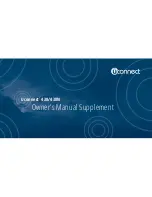
www.dbtechnologies.com
VIO L210
6
Rev 1.0 cod. 420120248Q
A seventh “Bass boost” position assign particular
emphasis on the lower frequencies, while the “service”
one allow USB port communication for firmware
updating. The “HIGH FREQUENCY COMPENSATION”
can act on medium-high frequencies. The user can
choose a “FLAT” position (which give a flat
equalization in this frequencies band), and other 7
positions, depending on the distance between the line-
array and the audience (in meters and feet).
c)
Connect the power link output (
10
) of the first
module to the mains input (
9
) of a second VIO L210
module of the line-array, and so on, in order to link the
power supply between all the elements. The
maximum linkable rated power and current depends
on the first module connection (type of cable, type of
connector used). The plate data give information
about the entire linked line-array system. The
maximum number of linkable modules is 10 VIO L210s
at 220-240 V, and 7 VIO L210s at 100-120 V.
d)
In case of remote control, connect the proper
Data Input (
2
) of the first module of the line-array to
the hardware remote controller (RDNet Control 2 or
RDNet Control 8) with cables equipped with etherCON
connectors. Then connect the Data Output (
2
) of the
first module to the Data Input (
2
) of the second one,
and so on. When the RDNet network is on and it has
recognized the connected device, the LED “Link” (
3
) is
on. The other LEDs (3) “Active” start blinking when
there is the presence of data transmission, the
“Remote Preset Active” advise that all the local
controls set on the amplifier panel (level, DSP presets,
etc.) are by-passed and controlled remotely by RDNet.
See also RDNet Control 2 and RDNet Control 8 user
manuals for further information.
e)
Connect the power supply (
9
) to the first
module. The related “Ready” LED (
7
) turns on,
signaling the proper power connection. The “Signal”
LED (
7
) start blinking at the presence of audio signal
(greater than -20dBu). Avoid audio distortion
conditions, potentially signaled by the “Limiter” LED
(
7
).
5) Software (dBTechnologies Network and
dBTechnologies Composer)
VIO L210 can be fully remote controlled via RDNet.
The connection details have been illustrated in the
chapter 4 (“d” point). In remote control mode, the use
of free professional
software,
developed by
dBTechnologies,
allows
a
complete
system
management:
dBTechnologies
Network
and
dBTechnologies Composer.
a)
dBTechnologies Network
The software which must be used in case of remote
control is dBTechnologies Network. This software can
control different speakers in different configurations.
It allows a complete remote control and a full real-time
monitoring in various scenarios. For example, the user
can control a setup with 2 line-arrays of VIO L210 and
3 VIO S318 subwoofers, and change different
parameters while the entire system is sounding.
It can also offer a deeper loudspeaker control than the
simple rear amplifier panel rotaries.
It can be downloaded for free from the official site:
www.dbtechnologies.com/EN/Downloads.aspx
Check always for software updates!
IN FLOWN CONFIGURATION, IT IS ADVISABLE TO
START ALL THE CONNECTIONS FROM THE TOP
(“FIRST ELEMENT”) OF THE LINE-ARRAY, TO
OBTAIN THE BEST CABLES MANAGEMENT, IN
ACCORDANCE WITH THE FOLLOWING SCREENS OF
“DBTECHNOLOGIES NETWORK” SOFTWARE.


























